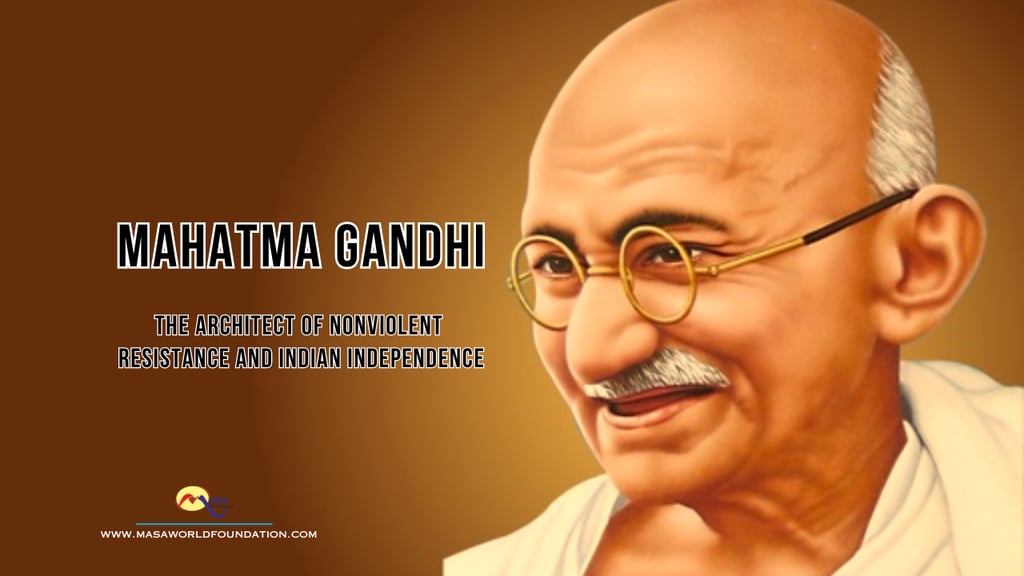Mahatma Gandhi: The Architect of Nonviolent Resistance and Indian Independence
BIOGRAPHYSOCIAL IMPACT
8 min read


Mohandas Karamchand Gandhi, later known as Mahatma Gandhi, was born on October 2, 1869, in Porbandar, a coastal town in present-day Gujarat, India. His family belonged to the Vaishya (merchant) caste, a status that provided them with a modest yet respectable position in society. His father, Karamchand Gandhi, served as the dewan (chief minister) of Porbandar, and his mother, Putlibai, was a deeply religious woman, whose piety and devotion to Hindu rituals significantly influenced young Gandhi's upbringing.
Gandhi's early education took place in his hometown and later at the Alfred High School in Rajkot. He was an average student but exhibited a keen interest in moral and ethical questions from a young age. The formative years saw Gandhi absorbing the principles of Jainism, a religion that held a strong sway in Gujarat. Jain tenets of ahimsa (nonviolence) and satya (truth) left an indelible mark on his consciousness, sowing the seeds for his lifelong commitment to these values.
In 1888, at the age of 18, Gandhi traveled to London to pursue legal studies at the Inner Temple, one of the four Inns of Court. This period was transformative, exposing him to Western ideas and philosophies. He avidly read texts on law, politics, and philosophy, including works by Henry David Thoreau, Leo Tolstoy, and John Ruskin. These readings, coupled with his interactions with the Theosophical Society, broadened his intellectual horizons and deepened his understanding of nonviolent resistance.
Gandhi's sojourn in England was crucial in fortifying his ethical framework. He experimented with vegetarianism, influenced by his mother's dietary habits and the vegetarian movement in London. This phase also saw Gandhi grappling with the complexities of truth, honesty, and moral integrity, themes that would later crystallize in his philosophy of Satyagraha, meaning 'truth force' or 'soul force.' Through these early experiences, Gandhi was gradually molded into the visionary leader who would eventually steer India toward independence through nonviolent means.
Formative Years in South Africa
Mahatma Gandhi's transformative journey in South Africa profoundly shaped his philosophy of satyagraha, or nonviolent resistance. Arriving in South Africa in 1893 as a young lawyer, Gandhi was immediately confronted with the harsh realities of racial discrimination. An infamous incident during his early days in the country, where he was forcibly removed from a first-class railway compartment despite holding a valid ticket, served as a catalyst for his lifelong commitment to justice and civil rights.
Gandhi's experiences in South Africa were instrumental in developing his methods of peaceful protest. He quickly became a prominent leader within the Indian community, which faced systemic discrimination under the colonial regime. He organized the Indian community to challenge unjust laws, employing nonviolent means such as petitions, negotiations, and peaceful demonstrations. One of the most notable campaigns was against the Black Act of 1906, which required Indians to carry registration documents. Gandhi's steadfast leadership during this period set the foundation for his philosophy of satyagraha, emphasizing truth and nonviolence as powerful tools for social change.
In 1904, Gandhi established his first ashram, the Phoenix Settlement, near Durban. This communal living experiment was pivotal in Gandhi's ideological development. The ashram embodied principles of simplicity, self-sufficiency, and communal living, which were central to Gandhi's vision of a just society. It also became a training ground for his followers, who learned the values of nonviolent resistance and self-discipline. The Phoenix Settlement and later the Tolstoy Farm, founded in 1910, were critical in nurturing the ideals that Gandhi would later bring to the Indian independence movement.
Gandhi's formative years in South Africa were marked by significant personal and ideological growth. Through his leadership in the Indian community's struggle for civil rights, he solidified his commitment to nonviolence and justice. These experiences laid the groundwork for his later efforts to lead India to independence and inspired movements for civil rights and freedom across the world.
Return to India and Rising Leadership
In 1915, after years of successful advocacy against racial discrimination in South Africa, Mahatma Gandhi returned to India, marking a pivotal moment in the Indian independence movement. His arrival was met with great anticipation, as his reputation as a formidable leader preceded him. Gandhi's initial activities were focused on understanding the Indian socio-political landscape, which led him to travel extensively across the country to connect with the masses and grasp their grievances. This deep immersion into the lives of ordinary Indians laid the foundation for his future strategies.
One of Gandhi's early significant involvements was his work in Champaran, Bihar, in 1917. The region was plagued by the exploitation of indigo farmers by British planters. Gandhi's intervention, through nonviolent protest and civil disobedience, eventually led to the alleviation of these oppressive practices. This success in Champaran established Gandhi's methodology of satyagraha, or nonviolent resistance, and elevated his standing among the Indian populace.
Following Champaran, Gandhi led another crucial movement in Kheda, Gujarat, in 1918. Here, he supported peasants who were unable to pay taxes due to crop failure and famine. Through organized non-cooperation and negotiations, Gandhi managed to secure tax relief for the farmers, further solidifying his reputation as a champion of the oppressed. These movements demonstrated Gandhi's ability to mobilize the masses effectively through peaceful means, setting a precedent for future campaigns.
As Gandhi's influence grew, he became a central figure in the Indian National Congress, advocating for broader participation in the struggle for independence. His strategy was rooted in empowering the common people through nonviolent protest and civil disobedience, which he believed were the most ethical and effective tools against colonial rule. By mobilizing the masses and promoting unity, Gandhi's leadership began to shape the Indian independence movement into a formidable force, poised for significant impact on the British colonial establishment.
Major Campaigns and Movements
One of Mahatma Gandhi's most significant contributions to the Indian independence movement was his leadership in various major campaigns and movements. Among these, the Non-Cooperation Movement, the Salt March, and the Quit India Movement stand out for their profound impact on challenging British rule in India.
The Non-Cooperation Movement, initiated in 1920, was Gandhi's first large-scale attempt to dislodge British authority through nonviolent means. The movement aimed to induce a mass refusal to cooperate with the colonial government, urging Indians to boycott British goods, institutions, and honors. This widespread campaign saw extensive participation from all sections of society, leading to significant economic and administrative disruptions. Through acts of peaceful resistance, the Non-Cooperation Movement underscored the power of collective action and nonviolent protest in undermining colonial control.
In 1930, Gandhi launched the Salt March, also known as the Dandi March, as a direct action campaign against the British monopoly on salt production and sales. This 240-mile trek from Sabarmati Ashram to the coastal village of Dandi galvanized the nation, drawing international attention to the injustices of British economic policies. By symbolically making salt from the sea, Gandhi demonstrated the potency of civil disobedience. The Salt March inspired widespread acts of defiance across the country and significantly boosted the morale of the Indian independence movement.
The Quit India Movement, initiated in 1942, was another pivotal campaign led by Gandhi. With the demand for immediate British withdrawal from India, this movement marked a decisive moment in the struggle for independence. Despite facing severe repression, including mass arrests and violence, the movement saw widespread participation from diverse segments of Indian society. The relentless spirit of the Quit India Movement demonstrated the unyielding resolve of the Indian populace to achieve self-rule, further weakening British hold over the country.
These major campaigns and movements were instrumental in fostering a sense of unity and purpose among Indians. Gandhi's nonviolent tactics not only challenged British rule but also galvanized Indian society, laying a strong foundation for India’s eventual independence in 1947. Through these efforts, Gandhi emerged as a pivotal figure, embodying the principles of nonviolence and civil disobedience in the pursuit of justice and freedom.
Philosophy of Nonviolence and Legacy
Mahatma Gandhi's philosophy of nonviolence, or ahimsa, forms the cornerstone of his approach to resistance and activism. Ahimsa, translating to 'non-injury' or 'non-harm,' is more than a strategy; it is a way of life that encompasses all actions, thoughts, and intentions. Gandhi believed that true strength lies in the ability to abstain from violence and to act with compassion and understanding. His commitment to nonviolence was deeply intertwined with his other foundational principles, such as simplicity, self-reliance, and truth, known as satya.
Gandhi’s principle of simplicity was not just about living with fewer possessions but also about focusing on what is essential and meaningful. This approach encouraged self-reliance, promoting the idea that individuals and communities could be self-sufficient, especially in the face of oppressive regimes. Through the promotion of khadi (hand-spun cloth), Gandhi emphasized the importance of economic independence and resistance to industrial exploitation. This, combined with his adherence to satya, urged individuals to live truthfully and with integrity, fostering a moral and ethical framework within the independence movement.
Gandhi's philosophy of nonviolence had far-reaching implications beyond the borders of India. His methods of peaceful resistance and civil disobedience inspired global leaders and movements. Notably, Martin Luther King Jr. drew heavily on Gandhi's teachings during the Civil Rights Movement in the United States. King adopted the principles of nonviolent protest to challenge racial segregation and injustice, demonstrating the universal applicability of Gandhi's ideas. Similarly, Nelson Mandela and the anti-apartheid movement in South Africa were influenced by Gandhi’s strategies, emphasizing the power of peaceful resistance against systemic oppression.
Gandhi's enduring legacy is a testament to the power of nonviolent resistance and ethical activism. His teachings continue to inspire current and future generations to pursue justice and equality through peaceful means. The global impact of his philosophy demonstrates that the principles of ahimsa, simplicity, self-reliance, and satya transcend cultural and national boundaries, offering a timeless blueprint for social change.
Final Years and Assassination
In the final years of his life, Mahatma Gandhi remained steadfast in his mission to promote peace and unity within India, despite the tumultuous atmosphere surrounding the country's partition. As communal violence erupted between Hindus and Muslims, Gandhi's commitment to nonviolence and reconciliation became more crucial than ever. He undertook fasts and engaged in dialogues with leaders from both religious communities, seeking to mitigate the bloodshed and foster a spirit of harmony.
Gandhi's vision of a united India faced significant challenges as the subcontinent was divided into India and Pakistan in 1947. The partition led to widespread violence, and Gandhi's efforts to quell the discord saw him traveling to riot-affected areas, urging for peace and mutual respect. His advocacy for Hindu-Muslim unity was not universally welcomed, and he faced opposition from various quarters, including those who viewed his stance as overly conciliatory towards Muslims.
On January 30, 1948, Gandhi's life was tragically cut short when Nathuram Godse, a Hindu nationalist, assassinated him during a prayer meeting in New Delhi. Godse's motivation stemmed from his belief that Gandhi's policies were detrimental to Hindu interests. The assassination sent shockwaves throughout India and the world, marking a somber end to the life of a man who had become a global symbol of nonviolent resistance and moral integrity.
The impact of Gandhi's death was profound. In India, it led to widespread mourning and a renewed commitment to his principles of nonviolence and unity. Internationally, Gandhi's assassination underscored the power and peril of pacifist movements, inspiring future leaders and activists in their own struggles for justice and peace. Figures such as Martin Luther King Jr. and Nelson Mandela drew inspiration from Gandhi's example, incorporating his methods into their own campaigns against oppression.
Gandhi's legacy endures, reminding the world of the enduring power of nonviolent resistance. His life and teachings continue to resonate, encouraging contemporary movements to pursue change through peaceful means, and underscoring the universal quest for justice, equality, and human dignity.
